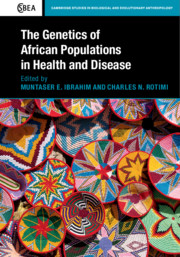Book contents
- The Genetics of African Populations in Health and Disease
- Cambridge Studies in Biological and Evolutionary Anthropology
- The Genetics of African Populations in Health and Disease
- Copyright page
- Contents
- Contributors
- 1 Reflections on Conceptualizing Africa for Biological Studies with a Historical Component
- 2 History and Genetics in Africa
- 3 Disease, Selection, and Evolution in the African Landscape
- 4 Genetic Susceptibility to Visceral Leishmaniasis
- 5 Genetics of Infection in Sub-Saharan Africa
- 6 Pharmacogenomics and Infectious Diseases in Africa
- 7 A Glimpse into Pharmacogenomics in Africa
- 8 Genomics of Cardiometabolic Disorders in Sub-Saharan Africa
- 9 Breast Cancer in African Populations
- 10 Sociobiological Transition and Cancer
- 11 The Genetic Epidemiology of Orphan Diseases in North Africa
- 12 Birth Defects and Genetic Disease in Sub-Saharan Africa
- 13 Neurogenetic Disorders in Africa: Hereditary Spastic Paraplegia
- 14 Enabling Genomic Revolution in Africa
- Index
- References
1 - Reflections on Conceptualizing Africa for Biological Studies with a Historical Component
A Small Essay
Published online by Cambridge University Press: 02 December 2019
- The Genetics of African Populations in Health and Disease
- Cambridge Studies in Biological and Evolutionary Anthropology
- The Genetics of African Populations in Health and Disease
- Copyright page
- Contents
- Contributors
- 1 Reflections on Conceptualizing Africa for Biological Studies with a Historical Component
- 2 History and Genetics in Africa
- 3 Disease, Selection, and Evolution in the African Landscape
- 4 Genetic Susceptibility to Visceral Leishmaniasis
- 5 Genetics of Infection in Sub-Saharan Africa
- 6 Pharmacogenomics and Infectious Diseases in Africa
- 7 A Glimpse into Pharmacogenomics in Africa
- 8 Genomics of Cardiometabolic Disorders in Sub-Saharan Africa
- 9 Breast Cancer in African Populations
- 10 Sociobiological Transition and Cancer
- 11 The Genetic Epidemiology of Orphan Diseases in North Africa
- 12 Birth Defects and Genetic Disease in Sub-Saharan Africa
- 13 Neurogenetic Disorders in Africa: Hereditary Spastic Paraplegia
- 14 Enabling Genomic Revolution in Africa
- Index
- References
Summary
Pliny the Elder said, to paraphrase, that there was always “something new out of Africa.” The place that was Africa for Pliny and the Romans was in supra-Saharan and northern Saharan Africa, specifically a region that encompasses the current state of Tunisia, the location of the ancient city-state of Carthage. By Pliny’s time, Carthage and the surrounding territories were a colonized region, specifically a Roman (and Romanized) province (called Africa). During the Islamic period, the name Africa passed into Arabic as Ifriqiya, and the same region was known by this name for a millennium until it began to be called Tunis. The Ottomans continued to use this name. During French colonial occupation this “protectorate” was called Tunisia and the name was kept after independence. In many instances, Pliny’s Africa, as Africa, has all but been forgotten in the conceptualization and naming of Africa, an irony of sorts – given that it was an Amazigh king from this region, Massinissa, who first said “Africa for the Africans,” in the heady days of various interactions within and between the region and Rome.
- Type
- Chapter
- Information
- Publisher: Cambridge University PressPrint publication year: 2019
References
- 1
- Cited by



